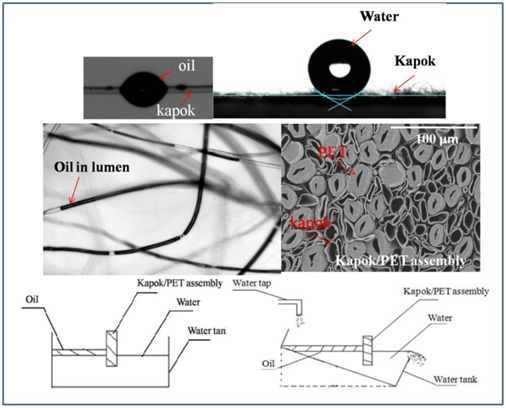Recently, Netherlands journals (‘Industrial Crops and Products’ and ‘Journal of hazardous materials’) published several interesting papers about the application of kapok fiber as the natural oil sorbent for oily water separation. The main researcher includes Guangbiao Xu who is a professor at the college of textile in Donghua University. In the papers, micro oil behaviors of single kapok fiber and fiber assemblies were reported. It was interesting that kapok fibers showed dual-scale oil sorption capacity due to its lumens and pores between fibers. A dual-scale oil sorption model which clarifies the important role of kapok lumens on oil absorbed of kapok assemblies was developed. In another paper, it was showed that highly porous oil sorbentbased on hollow kapok fibers was prepared by air-laying-bonding method with application of air flow in web forming and bonding to minimize damage of the fibers, particularly the hollow lumen structure. As prepared sorbent was reported to be used as a highly efficient interceptor for floating oil on static and running water.

In recent years, the increasingly serious oil pollution caused by oil spillages has aroused a vast concern all over the world. To deal with those of oil polluted water, mechanical extracting oil from water by sorption materials is widely used. The commonly used synthetic sorbents are usually made from oil byproducts. Some problems like complicated preparation process, unstable oil sorption, non-degradable property etc trigger an intensive interest in natural sorbents. Kapok fiber is a naturally hydrophobic and oleophilic plant fiber which is attracting various academic attentions for its unique hollow lumen structure. As a natural sorbent for oil sorption, the excellent oil sorption capacity of kapok fibers were reported by researchers from Nanyang Technological University, Universiti Teknologi Petronas and Indian Institute of Technology, as well as Prof. Aiqin Wang in Chinese Academy of Sciences and Prof. Guangbiao Xu in Donghua University.
The researchers in Prof. Guangbiao Xu’ group found that the surface energy of kapok fibers was just 49.65 mN/m with most of its components contributed by dispersion composition (44.74 mN/m). During oil sorption process, the oils are firstly adsorbed onto kapok fiber by hydrophobic interactions and van der Waals forces between oils and the waxy surface, and then enter the kapok assemblies and penetrate into the kapok lumens through internal capillary movement. Based on Washburn Capillary Theory, a dual-scale oil sorption model which clarifies the influence of kapok lumens and pore structure on oil sorption of kapok assemblies was developed. It was found that the big lumen of kapok fiber contributed considerably to the oil sorption capacity of kapok assembly, which was further enhanced with increasing kapok packing density. At the tightly packed condition of 0.10 g/cm3, oil absorbed by kapok lumens accounted for up to one fifth of the total oil absorption of kapok assembly. Furthermore, highly porous oil sorbentbased on hollow kapok fibers was prepared by air-laying-bonding method with introduction of polypropylene/polyethylene sheath-core composite fibers (ES). The usage of air flow in web forming and bonding was favorable for preparation of highly porous structure with minimum damage to the fibers. It was showed that as prepared porous sorbents consisting of kapok and hollow PET fibers had porosities up to 98.02 %. Per unit mass of the sorbent absorbed 43 ~ 63 g of oils with over 80% absorbed oils retained after 24 h dripping. Interestingly, the sorbent was used as the interceptor for floating oil on static and running water. The research showed the different stages of oil leaking through the sorbent. The theoretical and technical research work on kapok fiber will be critical for its application in but not limited to oily wastewater control.
The research was published with Prof. Guangbiao Xu as the corresponding author and his doctoral student (Ting Dong), as the first author. It was financially supported by “the Fundamental Research Funds for the Central Universities” and “Donghua university doctorial innovation fund for 2014~2015”. The papers can be now found at Industrial Crops and Products61 (2014): 325-330; Industrial Crops and Products76 (2015) 25-33; Journal of Hazardous Materials 305 (2016): 1-7.
.

